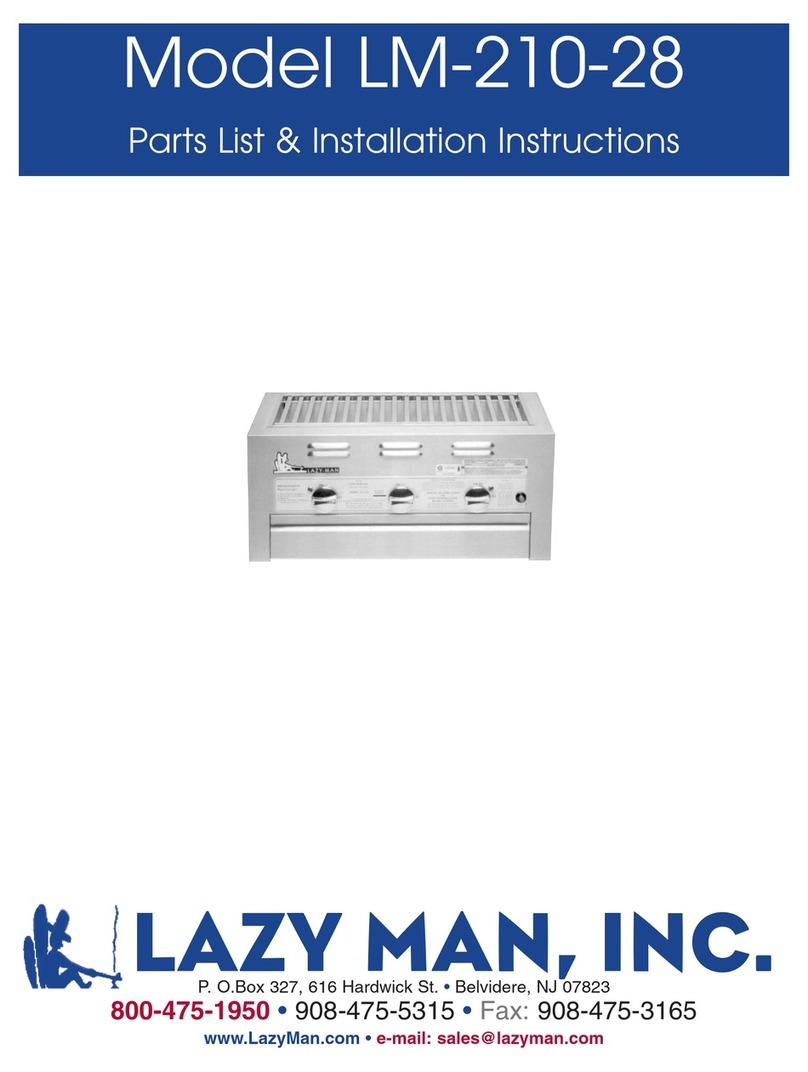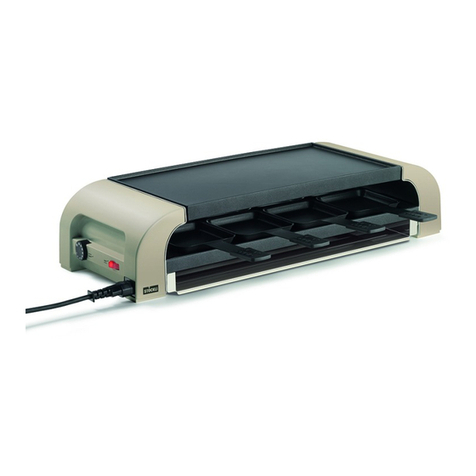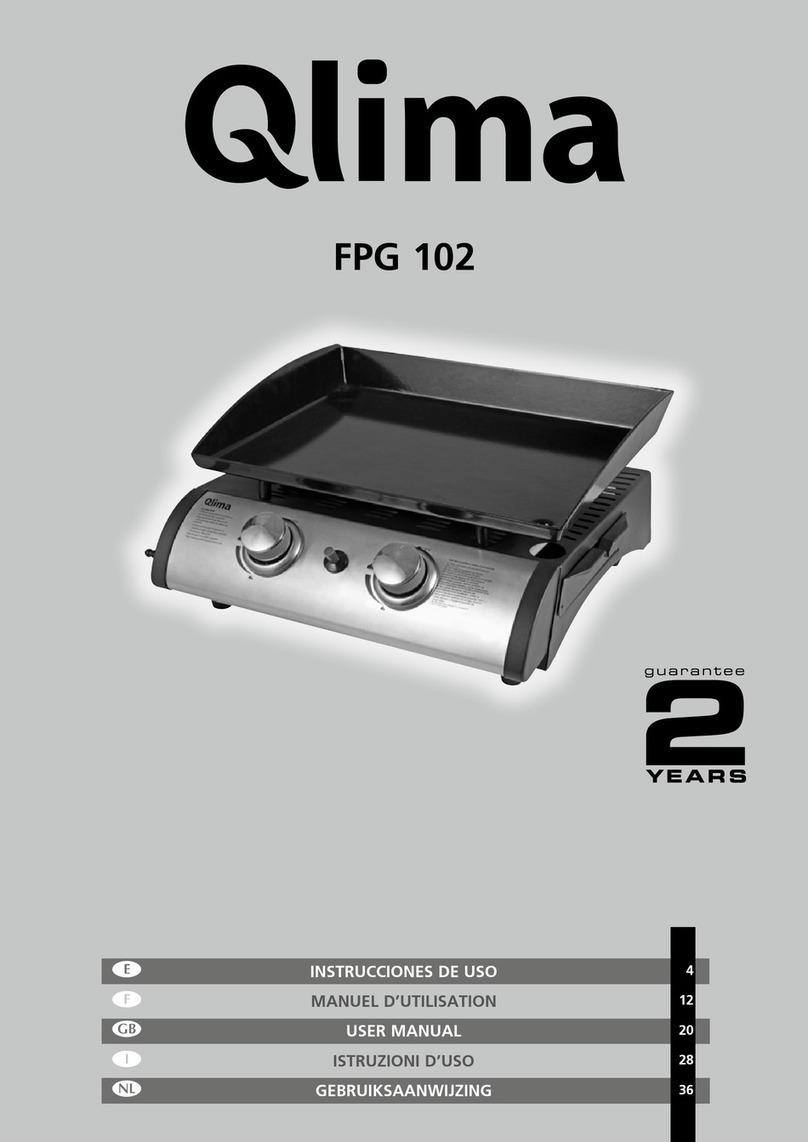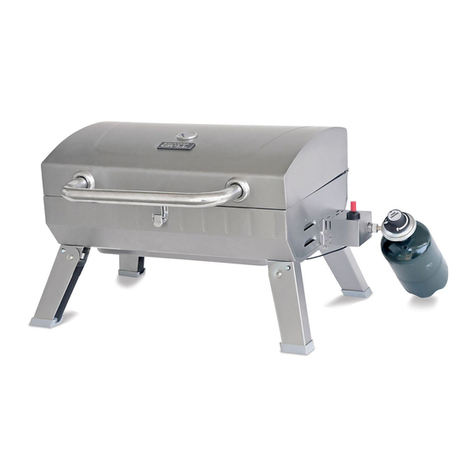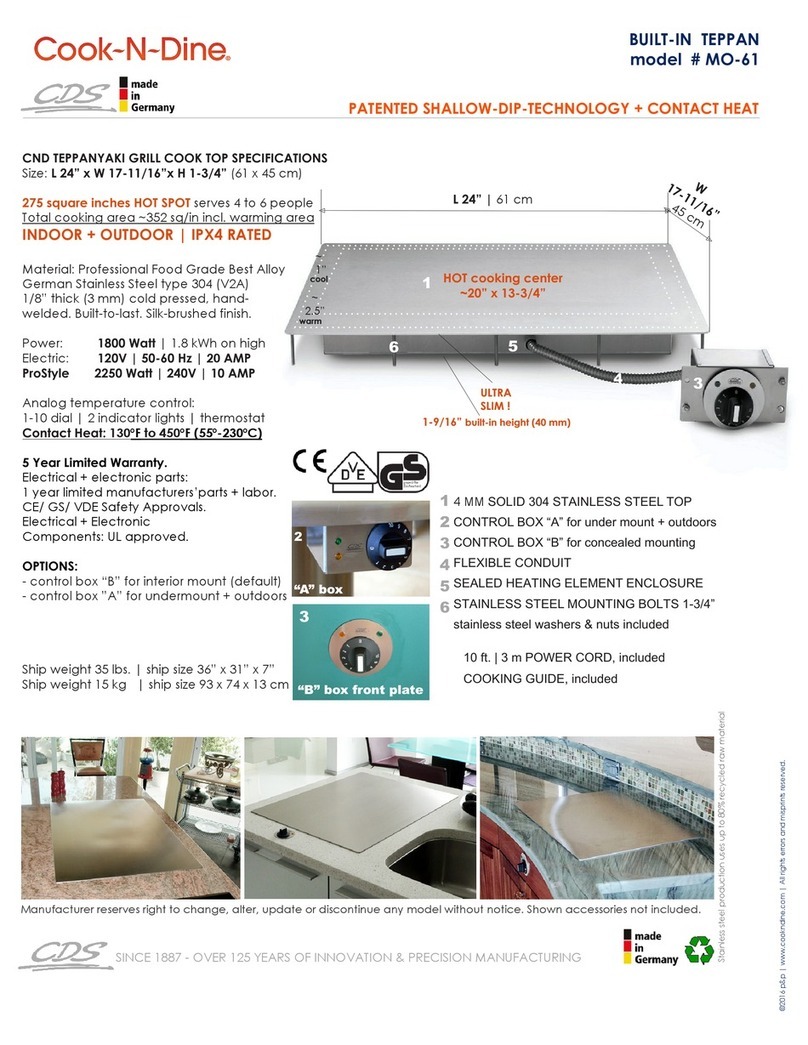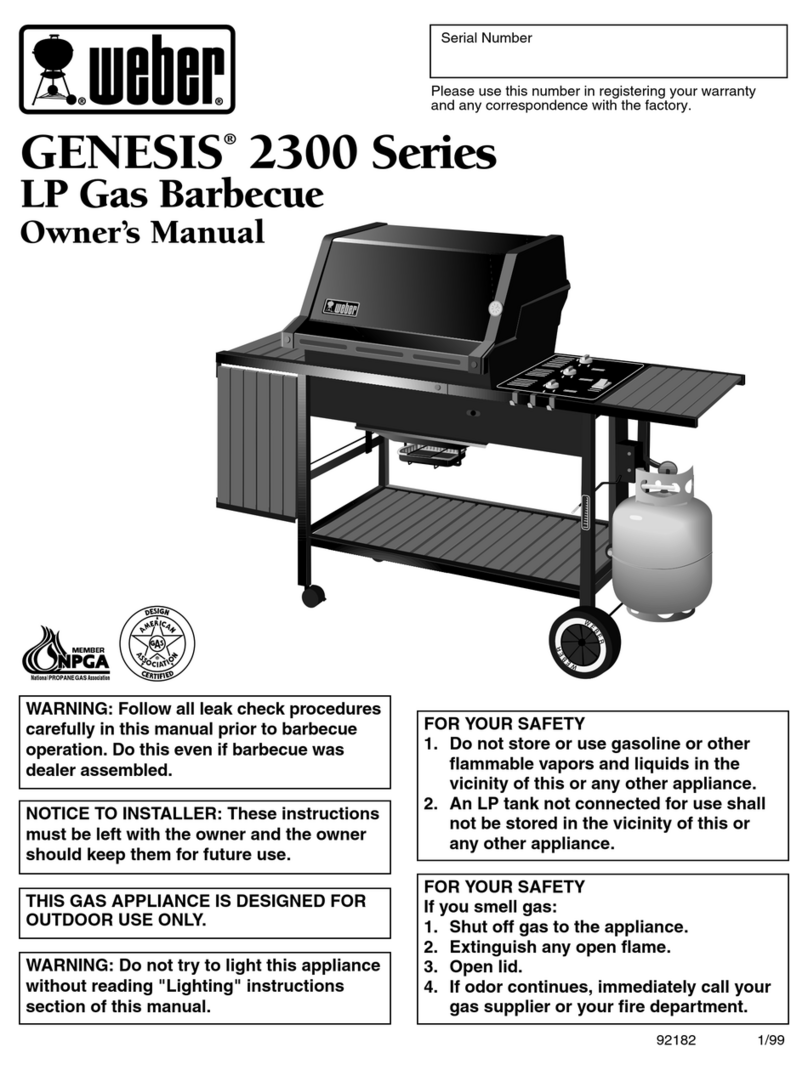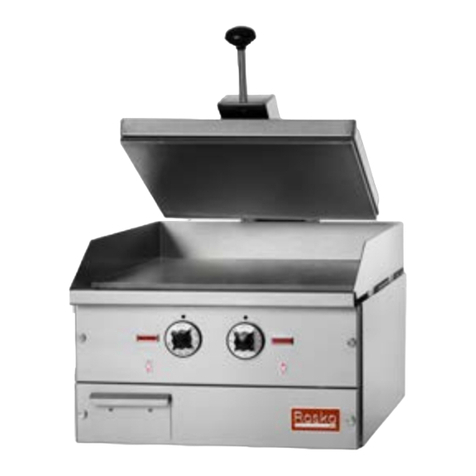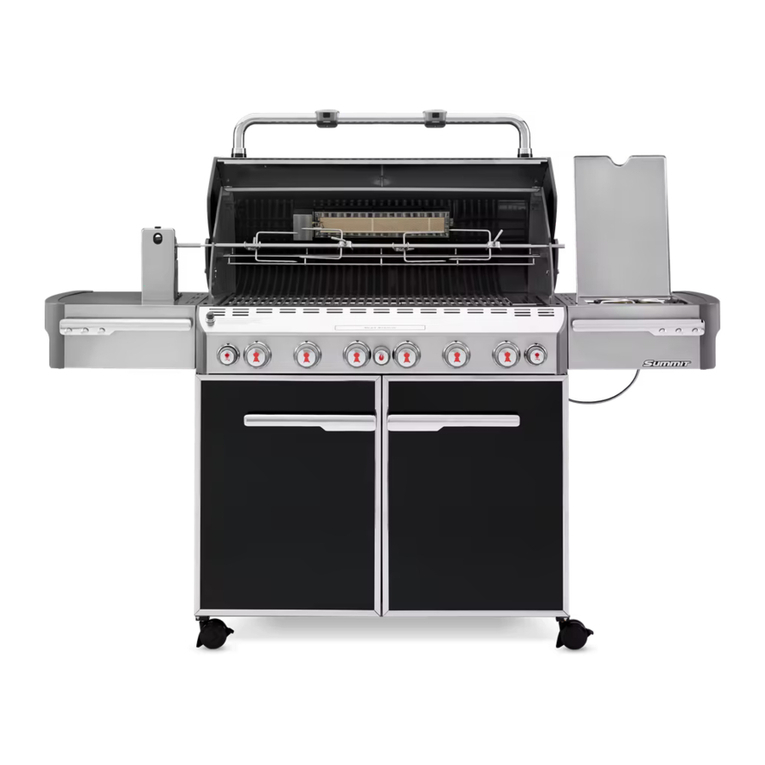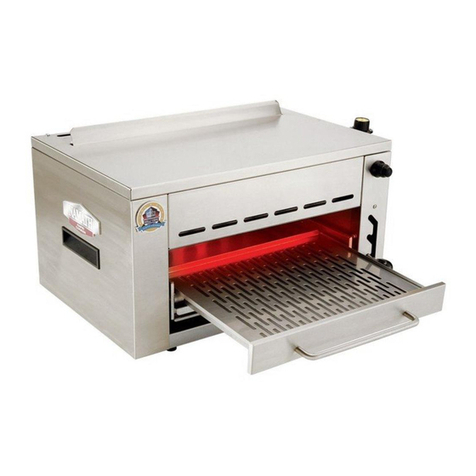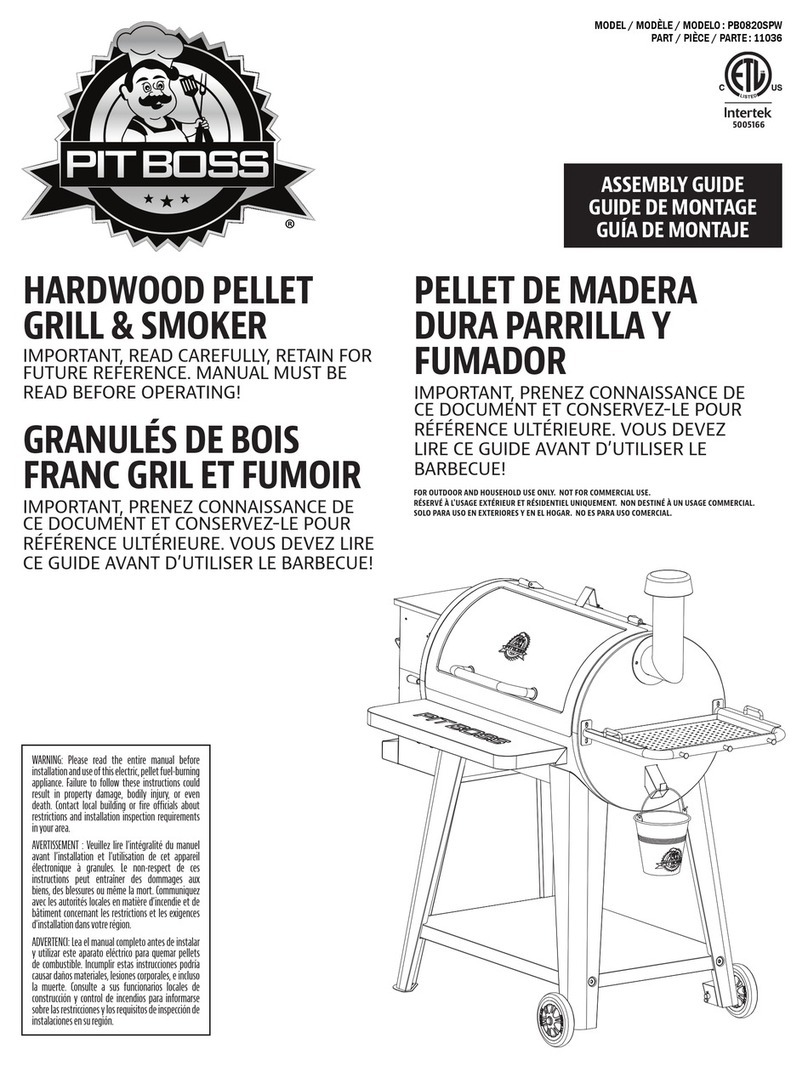LazyMan LM210-20 User manual

`
LazyMan Gourmet Grills
USE AND CARE GUIDE
LM210-20 LM210-30

WARNING
READ THIS MANUAL CAREFULLY and completely before using your grill to reduce the risk of:
1. Fire
2. Burn hazard, personal injury, or property damage
3. Burned food or unpleasant cooking experiences
4. Unapproved installation or servicing
THIS PRODUCT IS DESIGNED FOR OUTDOOR USE ONLY. Improper installation, adjustment, alteration, service,
or maintenance can cause property damage, injury, or death.
Read this manual thoroughly before installation, use, or servicing of this product
DANGER
IF YOU SMELL GAS:
1. Shut off all gas supply lines to the grill.
2. Extinguish any open flames.
3. If the gas odor continues, keep everyone away from the grill and immediately call your gas company
or fire department.
WARNING
1. DO NOT store or use gasoline or any other flammable liquids in the vicinity of this or any other
appliance.
2. Propane (LP) gas cylinders, not connected to the grill, should NOT be stored in the vicinity of this, or
any other appliance. Propane cylinders must be stored outdoors.
WARNING
1. The burning of gas cooking fuels generates by-products which are on the list of substances, known by
some states, to cause cancer or reproductive harm.
2. To minimize exposure to such substances, always operate this appliance according to the use and care
instructions found in this manual.
3. NOTE TO INSTALLERS: assure that grill owner receives this manual after installation.
i

WARNING
1. Never use dented, rusty, or damaged propane cylinders. Never store additional or empty propane
cylinders next to, or in the vicinity of this or any other appliance. Never store propane cylinders
indoors or on their sides.
2. Children should NEVER be left alone or unattended in the area where the appliance is located.
Place your grill unit well away from areas where children play. Do not store items that may be of
interest to children, in or around the grill or island enclosure.
3. Never attempt to move the appliance when hot. When in use, portions of the grill are hot enough
to cause severe burns.
4. Always maintain the required clearances to combustibles as detailed in this manual. This grill is
designed for outdoor use ONLY. Never use inside a garage, building, shed, breezeway, or other
enclosed area. Do not use this appliance under any overhead combustible construction.
5. Gas grills are not designed or certified to be used or installed on any recreational vehicle, portable
trailers, boats, or any other moving installation.
6. Always have an ABC fire extinguisher accessible. Never attempt to extinguish a grease fire with
water or other liquids.
7. If this appliance is removed and stored INDOORS, leave propane cylinders OUTDOORS in a well
ventilated area, away from heat or where children may have access to them.
8. Do not repair or replace any part of this grill unless specifically recommended in this manual.
9. If this appliance is installed by a professional installer or technician, be sure that he/she shows you
where the gas supply shut-off valve is located. All gas lines must have a shut-off valve that is readily
and easily accessible. If you smell gas, check for leaks IMMEDIATELY. Refer to section entitled ‘Leak
Test Procedure’. Check leak with soap and water only. Never use an open flame to check for gas
leaks.
10. When using a propane cylinder, inspect the gas supply hose prior to each use of the grill. If there is
excessive abrasion or wear, or the hose is cut, it must be replaced before using the grill.
11. THIS MANUAL MUST REMAIN WITH THE PRODUCT OWNER FOR FUTURE REFERENCE.
To obtain replacement parts or service, contact:
LazyMan Inc. 560 Independence Street, Belvidere, NJ 07823
Customer Service (908) 475-5315 (800) 475-1950
ii

TABLE OF CONTENTS
Important Safety Precautions…………………………………………………………………….…1
Built-in Grill Application Requirements and Cutouts…………………………………….2
Island Installations………………………………………………………………………………………..4
Gas Connections…………………………………………………………………………………………..6
Natural Gas (NG)…………………………………………………………………….……………..…..6
Liquid Propane (LP)…………………………………………………………………………..….…… 6
Final Checks………………………………………………………………………………………………..8
Operation of Your Grill…………………………………………………………………………………10
Introduction……………………………………………………………………………………………..10
Checklists…………………………………………………………………………………………..…….10
Manual Lighting………………………………………………………………………………………..11
Lighting Your Grill……………………………………………………………………………………..12
Cleaning Your Grill………….………………………………………….…………………………..……13
Troubleshooting……………………………………………………………………….………………….15
Replacing the Electronic Igniter……………………………………………………………….…..19
Exploded View Parts Lists…………………………………………………………………….……...20
LazyMan Warranty Information…………………………………………………………………...22
iii

IMPORTANT SAFETY PRECAUTIONS
1. The LazyMan LM210 Series grills arrive nearly fully assembled and require only minor assembly steps.
Assure that ALL packaging materials have been removed before attempting to light the appliance. This
includes removing all shipping tie wraps, zip ties and cardboard. Remove the cooking grates and look
for ALL internal packaging materials INSIDE the grill. Last, peel off all protective vinyl coating from ALL
exterior and interior surfaces on the appliance.
2. Avoid wearing loose fitting clothing or long sleeves while cooking. They could ignite.
3. Never leave the appliance unattended while cooking.
4. Never touch the grill racks or surrounding metal surfaces with your bare hands while cooking. These
surfaces will be HOT.
5. The use of an insulated glove or mitt is recommended while cooking.
6. The stainless steel cover MUST BE removed before attempting to light the grill, as an explosion could
occur. Do not lean over the appliance when lighting.
7. Do not heat unopened food containers on the appliance, as, pressure will build up and the container
can explode.
8. Do not use aluminum foil on the grill racks. This will prevent proper ventilation and allow excessive
heat to build inside the grill. Such heat can damage components of the grill.
9. Never remove the drip pan while cooking. Always assure that it is pushed all the way in. Hot overflow
can leak downward and produce a fire or explosion. The drip pan should be cleaned on a regular basis
when the appliance is cold.
10. If burner does not light within 5 seconds, turn gas off and wait 5 minutes before attempting to re-light.
If any burner goes out during operation, turn burner off and check for adequate fuel. Wait 5 minutes
before attempting to re-light.
11. When using portable LP gas cylinders, always turn off the main valve on the cylinder after each use.
12. Use caution when operating the appliance in windy conditions. Wind can enter from the back or sides
and interrupt air flow. This can cause an overheating condition and damage the appliance and its
components.
13. This grill has been made with the finest materials available and, as a result, this grill is HEAVY. Always
use caution when moving or installing this product. Failure to follow this instruction can result in back
or other personal injuries.
1

BUILT-IN APPLICATION REQUIREMENTS AND CUTOUTS
All LazyMan grills are manufactured to very tight tolerances. To ensure the best possible fit, however, it is best
to purchase and have the grill available for the contractor BEFORE constructing a new island. As a guideline,
prepare your island cutout per the dimensions found in the chart above. The LazyMan LM210 Series built-in
grill is intended to be mounted and installed in a built-in enclosure (island) made from NON-COMBUSTIBLE
materials such as masonry, brick, or steel. For installations in wood or other combustible materials, LazyMan
offers a stainless steel insulation kit. These kits add extended cutout requirements as shown in chart and will
insulate most of the heat generated by the grill from the combustible construction. These kits are available
from your local dealer and are identified as follows:
STAINLESS STEEL INSULATION KITS:
SSIK-20- Insulation Kit for LM210-20
SSIK-30- Insulation Kit for LM210-30
2

BUILT-IN APPLICATION REQUIREMENTS AND CUTOUTS
The LM210 Series grill is designed to be placed in an island cutout that has a bottom in the cutout. The grill
rests inside and on the bottom of the cutout. Additionally, access holes will need to be cut in the bottom or
back to allow for pipe routing.
COMBUSTIBLE MATERIALS: the grill should be mounted so that there are no combustible materials within 12”
of the sides, front, or back of the grill.
See section entitled ‘Important Safety Precautions’, items #1. After unpacking, lift the appliance into place.
The cut-out dimensions provided should result in the grill side edges clearing the sides of the island cutout by
1/8” per side. Leave the grill partially out and away from the rear wall at this point. This will allow access for
gas hook-ups.
The island/ enclosure should have ventilation holes to prevent gas build-up in the event of a leak. See “Built-In
Application Requirements and Cutouts Diagram” for recommended cutouts. The MINIMUM vent size is 10” x
10” or an equivalent rectangular size creating 100 square inches in three places on the island enclosure.
The deck ledges need to flat and level to prevent uneven burner flames and soot build-up inside the grill. Refer
to ANSI Z21.58 Standard for Outdoor Cooking Gas Appliances. It is recommended that a 120Volt, 60 Hertz, 15
Amp GFI certified outdoor outlet be installed on a vertical wall of the island being constructed. This outlet will
be used for general purpose and is not required for his appliance. The REAR vertical wall of the island, if
present, is ideal for placing this outlet. All electrical connections must be installed by a qualified electrician.
STAINLESS STEEL
INSULATION KIT
COMBUSTIBLE
ISLAND
3

LM210-20 and LM210-30 ISLAND INSTALLATION
NOTE: Use this INSTALLATION section in conjunction with the following ‘GAS CONNECTIONS’ section to assure that all
gas considerations have been made before installing your appliance.
INSTALLATION- USING NG GAS: After the island has been constructed and built per the previous cutout
recommendations and guidelines, it’s now time to install the LazyMan 210 Series Burner into the island. The above
diagram shows a typical Natural Gas installation where the gas piping is routed through the back of the island and
externally to the gas source. This routing can also be accomplished internally (inside the island) if the island is
constructed with a hollow design and there is space between the back wall of the cutout and the back wall of the island.
This burner is shipped with a ½ NPT (female) fitting at the end of the gas manifold for both NG connections and LP hose
connections. It is also shipped with an NG regulator (for natural gas grills) and an LP regulator with hose for burners set
up for liquid propane.
It is highly recommended that a qualified plumber or gas technician make this installation and perform the gas hook-
up procedure.
1. Measure the distance from the back of the cutout to the back of the island. You will need a ½” pipe with ½”
NPT male threads at both ends that match this distance plus 2”. This pipe is called a ‘nipple’. Nipples come
pre-threaded at both ends and are available in a variety of different lengths.
2. Use pipe joint compound or Teflon tape (to seal the threads) FOR ALL PIPE CONNECTIONS and install this
first pipe into the fitting at the back of the appliance.
3. Using two or more people, carefully lift the burner into the island cutout and slide it toward the back of the
cutout. Allow the newly installed pipe to slide through the pre-cut hole or opening and through the back
wall of the island. Slide the burner all the way in so that the front of the burner is flush with the front of the
island.
4

4. Make your first connection using a ½” NPT female elbow. Point this elbow downward if the main gas supply
is near the ground. If the main gas supply is in a location other than the ground, point the elbow in that
direction.
5. Install a short nipple into the open end of the elbow and install the supplied NG regulator at the end of this
nipple. Make sure the regulator is installed so the arrow (marked on the regulator) is pointing to the
appliance, i.e., in the direction the gas will be flowing. NOTE: if this appliance is being installed in line and
after an adjacent grill, and that grill has a gas regulator, then DO NOT INSTALL the NG regulator to this
appliance. Only ONE regulator is required for all appliances connected to the same gas line.
6. Measure the distance from the open end of the regulator to the ground and subtract 8” from this
measurement to allow for the next 3 connections. This will be the length of your next nipple.
7. Install this nipple to the regulator and at the other end, install a ½” NPT female ‘Tee’ connection. The third
(downward) leg of the ‘Tee’ is used to install a 3” minimum length ‘Drip Leg’ with cap. This leg is required in
many states and is used for periodic moisture relief. Check your local codes. This complete pipe routing
should now be resting 1-2 inches above the ground.
8. Install the next nipple into the center opening of the ‘Tee’ and run this connection to the gas source.
IMPORTANT NOTE: If the gas source does not have a gas shut-off valve, then a new ½” quarter turn valve
MUST be installed between the last gas pipe and the existing gas source. This gas valve should be installed
by a qualified plumber or gas technician. See the next step.
9. If the gas source is a stubbed gas pipe coming from the side of the house or exit point, then THE GAS MUST
BE TURNED OFF AT THE METER. A new quarter turn gas valve must be installed, either at the gas source or
inline from the gas source in a convenient location.
10. Use the ‘Leak Test Procedure’ found in the ‘FINAL CHECKS’ section of this manual to check all gas
connections prior to operation of this appliance.
INSTALLATION- USING LP GAS (LIQUID PROPANE-BOTTLE)- when using bottled LP, then use the LP regulator and hose
equipped with the LP appliance. The installation should begin the same as the NG installation where a ½ NPT pipe
(threaded at both ends) is routed from the gas exit point at the rear of the appliance through the rear of the island. A ½
NPT female elbow is then added to the end of the ½ pipe. At this point, the hard piping is complete. Connect the fitting
at the end of the LP hose to the newly installed elbow. Use the above diagram for this hard piping requirement and
connection of the LP hose. As previously mentioned, if the island is constructed in a ‘hollow’ manner, and there is a
hollow space between the back of the cutout and the back of the island, then the first hard piping can be routed directly
DOWNWARD into the island interior. Additional fittings will be required. This piping can terminate with either a ½ NPT
female elbow or a ½ NPT straight coupler. The LP hose can then be connected directly to the last fitting. Always assure
that the LP hose is completely visible and accessible inside the island.
1. Use 2 or more people and lift the grill onto the top island surface.
2. Follow steps #1 through #4 of the NG piping installation. This portion of the installation completes the hard
piping requirements and routes the piping through the back of the island.
3. Use pipe joint compound or Teflon tape on the fitting at the end of the LP hose and install directly to the ½
NPT female elbow at the rear of the island.
4. Use the ‘Leak Test Procedure’ found in the ‘FINAL CHECKS’ section of this manual to check all gas
connections.
INSTALLATION- USING LP (LIQUID PROPANE) BULK TANK- If you have ordered a burner configured for LP (Liquid
Propane), then you have received an LP regulator and hose with your burner. If you plan to attach the appliance directly
to a bulk propane tank, then you cannot use the supplied hose. You must obtain a regulator from LazyMan Inc. Please
order P/N 10099. This is a regulator which converts from NG to LP. Please use the instructions that come with the
regulator for this conversion. Follow the same connection pattern shown above for NG connections.
5

GAS CONNECTIONS
This appliance has been factory pre-set to
use either Propane Gas (LP) or Natural Gas
(NG). It is critical that the gas you use
matches the gas that the grill has been set
up for. You can verify this by checking the
label mounted on the right rear side of the
appliance.
Ensure that the gas supplied meets
minimum pressure requirements, as shown
below, under full load:
PRESSURE (WATER COLUMN INCHES)
FUEL
MAXIMUM
MINIMUM
LP
14
11
NG
7
4
Both the regulator and the manifold orifices
have been set for the type of gas specified
on the label. If it is desired to convert to a
different type of gas, a gas conversion kit
must be obtained from LazyMan Inc. or
from one of its dealers, and must be
installed by a qualified technician.
NATURAL GAS:
LazyMan Inc. recommends that only a
qualified professional performs the
required gas hook-ups on this product.
To ensure satisfactory performance, the gas
supply line must be sized to accommodate
the TOTAL BTU requirements of all the gas
fired equipment that will be connected to
this line. Minimum pipe size should be 1/2”
I.D., however, 3/4" I.D. is recommended for
the long runs and best performance. For
this, a 3/4" FIP x 1/2” MIP reducer fitting
will be required (not supplied).
Calculate the total BTU output of all appliances
that will be attached to this line and use the
chart entitled “Gas Supply Line Runs” to
determine allowable run line distances. Failure
to meet these minimum run requirements will
reduce the performance of the appliance and
any other grills/appliances connected to this
line. In general, always keep the supply line run
as SHORT as possible.
The longer the gas run line, the lower the
gas pressure and the smaller number of
BTU’s the line can handle.
MAXIMUM GAS PIPING LENGTH
PIPING LENGTH (FEET,¾”
PIPE)
TOTAL BTUS (ALL
APPLIANCES ON LINE)
10
360,000
20
245,000
30
198,000
40
169,000
50
150,000
60
135,000
70
123,000
80
115,000
A gas shut-off valve must be installed between
the gas appliances and the gas line in an easily
accessible location. This valve should be
installed by a qualified plumber.
All pipe joints must be sealed with threading
tape or pipe joint compound. The first 2 threads
should be free and clear of any compound to
avoid the compound from entering into the
pipe. Never use threading compound on flare
fittings.
LIQUID PROPANE GAS:
Grills set up for LP gas come equipped with an
LP hose/regulator assembly for connection to a
standard 20 lb (5 gal) LP gas cylinder. All
6

GAS CONNECTIONS
fittings necessary to attach the hose
assembly to the grill are included.
BULK TANK LP:
Some residences and/or commercial
establishments use bulk propane cylinders
and are permanently plumbed with LP
connections. When this is the case, then a
4/11 regulator must be obtained and set for
the proper gas type (LP). 4/11 regulators
are convertible from NG to LP. To convert,
follow the instructions provided by the
regulator’s manufacturer.
WARNING
Do not change the regulator/ hose
assembly or use any other assembly other
than the one supplied with your LazyMan
grill.
Do not attempt to use a 5LP-A equipped
regulator/hose assembly with a standard
510 POL cylinder/valve assembly.
Do not store a spare LP gas cylinder under
or near this appliance
LP CYLINDER REQUIREMENTS:
The LP cylinder must be constructed and
marked in accordance with the U.S.
Department of Transportation (DOT) spec-
ifications for LP cylinders and be designed
for use with a Type 1 system only.
When exchanging your cylinder for a refill,
exchange only with a Type 1, 20 lb cylinder
with an overfill protection device.
Never use a cylinder with a damaged valve.
A dented or rusty LP cylinder may be
hazardous and should not be used. If in
doubt, have it checked by your LP supplier.
Always shut off the LP gas when finished
using the grill, both at the grill valves and
the LP cylinder valve.
Cylinders must always be stored outdoors in
a well ventilated area and out be of reach of
children. If your grill is stored indoors, the
LP cylinder must be removed and stored
outdoors.
LP CONNECTIONS:
Make sure the LP cylinder valve is fully
closed before connecting to the grill. It is
possible for the valve to be partially open
without releasing gas, but, as soon as the
regulator is connected, gas can leak from
the connection. Insert the regulator inlet
into the cylinder valve and turn the black
coupler clockwise until the coupler is hand
tight. Do not over-tighten this connection.
To disconnect the coupler, first make sure
the cylinder valve is turned completely off.
Turn the coupler counter-clockwise. The
inlet will then disengage.
Always leak test the connection after
refilling or exchanging LP gas cylinders. See
‘Leak Test Procedure’.
GAS LINE PURGING:
After refilling or replacing an LP gas
cylinder, it is always best to purge the
system of air before attempting to light the
grill.
Make sure all controls are in the “OFF”
position.
7

GAS CONNECTIONS
Make sure the LP cylinder valve is turned
‘OFF’.
Turn one or more of the grill burner valves
to ‘ON’. This releases pressure in the
system.
Close the burner valve(s) back to the ‘OFF’
position.
Turn the LP cylinder valve to the ‘ON’
position.
Light the burners as usual, one at a time, by
opening the valves slowly.
DANGER!
To prevent fire or explosion, DO NOT smoke
or allow any potential source of ignition
(sparks, electrical arcing, etc.) in the area
while performing a leak test. Leak tests
should be conducted outdoors only. NEVER
conduct a leak test using fire or flame.
FINAL CHECKS
LEAK TEST PROCEDURE:
Create a soapy solution of one part dish
soap and three parts water.
Confirm that all control knobs are in the
‘OFF’ position.
Turn on the fuel supply. For Natural Gas,
turn the valve handle 1/4 turn so the handle
is in-line with the pipe and gas flow.
For LP, turn the cylinder valve knob one
complete turn (minimum) in the counter-
clockwise direction.
Apply the soap solution generously with a
paint brush or squirt bottle on every
connection and fitting.
If bubbles appear to ‘grow’ on any of the
connections, then gas is escaping. Turn off
gas supply immediately.
FIXING A GAS LEAK: Make sure the main
gas supply has been turned ‘OFF’.
Turn all grill control knobs to ‘HIGH’ to
purge the system of any gas build-up, then
return them to ‘OFF’.
Wash off the soapy solution and then dry
off.
Tighten the loose joint or replace any fitting
that may be suspect.
For LP applications, do NOT attempt to
repair any leaks found at the main cylinder
valve. The LP cylinder needs to be replaced.
Repeat the leak test procedure to confirm
that no leaks are present.
8

GAS CONNECTIONS
BURNER FLAME-AIR SHUTTER
ADJUSTMENT
Air flow that enters the burner is controlled
by the ‘Air Shutter’. Each burner is installed,
adjusted and tested in the factory prior to
shipment. However, fluctuations in gas
pressure, gas conversions, and gas quality
can affect performance of the burner and
adjustments to the flame height may be
necessary.
Flames should be blue in color and stable,
with a slight yellow tip. The bright blue core
should be about 3/8” tall with a total flame
height of 1-1/2”.
The flames should burn quietly and not
appear to ‘lift’ up from the burner. If your
flames do not match this description, use the
following procedure.
To Adjust:
DANGER
BE EXTREMELY CAREFUL AROUND HOT
BURNERS AND ADJACENT GRILL PARTS.
Air shutters are located near the brass valves
at the front of each burner. Each burner
needs to be adjusted separately.
Begin by completely removing the drip pan
and setting it aside. The valve and burner air
shutter can be seen by looking upward at
them from the front. You will see a small
Phillips head screw which secures the air
shutter. Loosen this screw. NOTE: the air
shutter opening has been factory pre-set to
the half-way position.
Ignite the burner and observe the flame. By
opening or closing the air shutter opening,
the burner flame will change in color.
If the flame is too YELLOW, this indicates a
lack of air and excess carbon is being
produced. OPEN up the air shutter by sliding
it TO THE REAR. Use a flat screw driver or
other long steel tool to accomplish this. DO
NOT USE YOUR BARE HANDS OR FINGERS TO
MAKE THIS ADJUSTMENT. See also ‘Yellow
Burner Flames’ in the ‘Trouble Shooting’
section. If the flame is noisy (sounds like a
torch) and tends to lift up, then the air
shutter is delivering TOO MUCH air. Slide
the air shutter FORWARD slightly to CLOSE
the opening and reduce the air flow. Your
goal is to create the most efficient, quiet,
soft blue flame.
After adjusting each burner, tighten up the
Phillips head screw which secures the air
shutter.
Replace the drip pan. NEVER operate the
appliance without the drip pan installed, as
this can cause a potentially dangerous
condition.
9

OPERATION OF YOUR GRILL
INTRODUCTION
Outdoor burner appliances create more
heat than interior kitchen cooking ranges,
as the high-performance burner(s) creates a
much hotter flame. The burner(s) contained
in this appliance requires a constant, steady
supply of fresh air to mix with the fuel.
Using the burner in windy conditions may
disrupt the proper air flow. Wind can be
particularly disruptive (and damaging) if you
are cooking on HIGH. Excessive winds can
trap the hot air and gasses inside the
appliance and cause an overheating
condition. An early warning sign of this
condition can be seen by the lack of
apparent heat reaching the pot or pan. If
this is the case, turn down the heat.
Any damage caused by this overheating
condition is NOT COVERED by warranty.
PRE-COOKING CHECKLIST BEFORE YOUR
FIRST USE:
1. Make sure ALL packing materials have
been removed from the interior and the
exterior of the appliance. This includes the
removal of all protective vinyl coating found
on the appliance.
2. Make sure the fuel lines have been
connected per instructions in the
installation section of this manual.
AT EACH NEW SEASON:
At the start of each new grilling season, the
grill should be inspected. Remove the
weather cover and the top finger grate pan
from the unit. Remove the burner(s) by
sliding it toward the rear and off of the
valve orifice. Check the burner for any
apparent obstructions. Also check the
orifices at the tip of each valve. Look
especially for cotton-like or mud-like
formations. Spiders, wasps, and other
insects nest in these areas and can disrupt
air and gas flow, and can cause damage to
the grill or personal injury.
A wire brush can be used on the outside of
the burner(s) to remove any scale or foreign
matter. The inside of the burners can be
cleaned and flushed out with a garden hose.
Make sure burners are completely dry
before re-inserting into the grill.
Obstructions found in the orifice at the tip
of the valves can be cleared using a paper
clip or a small wire. Never use a wooden
toothpick as it can break off and clog the
hole.
As a final check, inspect all hoses and gas
lines for any evidence of damage.
By following these procedures, you can
keep your outdoor burner operating like
new for years to come. If you have any
questions, you can always call the factory at
(800) 475-1950
CHECKLIST BEFORE EACH USE:
Always make sure that:
1. You DO NOT smell gas BEFORE you light
the appliance. If you smell gas, shut
everything OFF and call a qualified
plumber to check for leaks. See also
section in this manual entitled ‘FINAL
CHECKS’ in the ‘GAS CONNECTIONS’
portion of this manual.
10

OPERATION OF YOUR GRILL
2. The cooking area is free from
combustibles that could ignite.
3. All control knobs turn freely.
4. All burners are seated properly.
5. Connections to any Propane cylinder, if
being used, have been leak tested.
6. If you are using a Propane (LP) cylinder,
be sure the valve has been turned ON
before attempting to light the grill.
7. If you are using Natural Gas (NG), be sure
that the main gas valve has been turned
ON before attempting to light the grill.
8. Wind is not blowing too strongly around
the sides or rear of the appliance.
WARNING
1. Never attempt to light the appliance if
you smell gas.
2. Never light the appliance before
removing the Stainless Steel Weather
Cover.
WARNING
3. DO NOT release fuel into a closed grill
before lighting. This will increase the risk
of explosion, property damage, personal
injury, or death.
4. When lighting, keep your face and body
as far from the appliance as possible. If a
burner does not light within 5 seconds, turn
the control OFF, and wait 5 minutes for the
gas to dissipate, before attempting to
reignite.
5. NEVER LEAVE THE APPLIANCE
UNATTENDED WHILE COOKING.
MANUAL LIGHTING OF YOUR GRILL:
Please become familiar with the following
section (next page) called “Lighting Your
Grill” before attempting to manually light
this appliance.
MANUAL LIGHTING
Manual lighting is used when the AAA
battery used to power your ignition is
discharged and there is no replacement
battery immediately available. Use either a
long wooden match or a long-tipped lighter
and insert between the large hole in the
finger grate pan and the edge of the burner
directly below. Turn the control knob to
‘HIGH’ to light the burner. Remove the
match or lighter.
11

LM210-20 AND LM210-30 SERIES BURNER CONTROLS
LM210-20
LM210-30
LIGHTING YOUR GRILL
Make sure control knobs are in the ‘OFF’ position.
For Natural Gas (NG) grills, turn the main gas
control to ON. The valve is ON when the valve
lever is in line and parallel to the gas piping and
gas flow.
For Propane (LP) grills, turn the propane cylinder
valve at least one full turn in the counterclockwise
direction.
LIGHTING PROCEDURE
Remove the weather cover from your grill.
Assure that the main gas source is turned
on, as shown above. Rotate the control
knob in a COUNTERCLOCKWISE direction
until the knob pointer is facing UP (HIGH
position).
AT THE SAME TIME, depress the
IGNITION switch on the front panel to ignite
the burner. The electronic igniter will
continue to spark as long as you depress
the switch. Once the burner is lit, you can
remove your finger from the switch.
Repeat the process for the second burner (if
you are lighting the LM210-30 model).
If, at any time, the burner does NOT light
after 5 seconds, then turn the burner control
knob to OFF and wait 5 minutes to allow
unburned gas to dissipate. After 5 minutes,
it will be safe to start the procedure again.
CONTROL
KNOB
IGNITION
SWITCH
15-7/8”
12”
LEFT
BURNER
CONTROL
KNOB
IGNITION
SWITCH
RIGHT
BURNER
CONTROL
KNOB
12”
28”
12

CLEANING YOUR GRILL
CLEANING YOUR GRILL
The LazyMan LM210 Series grill products
have been built with the finest grade of 304
stainless steel available. All exterior surfaces
feature a #4 brushed finish. With proper
maintenance, this finish will last for many
years. Here are a few pointers to keep your
appliance looking and functioning like new:
After each use, wipe down the complete
exterior of your grill using a soft cloth and a
commercially available stainless steel
cleaner. It is important to remove the
grease splatters and food debris at this
time, rather than allowing it to become
‘cooked on’. It will be much harder to
remove the next time.
Always wipe in the direction of the grain
finish. The front surfaces, the drip pan front,
and the weather cover have the grain
running in a horizontal direction.
GRAIN DIRECTION
When trying to remove a heavier grease
and dirt build-up, a mild mixture of dish
soap and warm water can be used for
cleaning. To remove the most stubborn
stains, a non- metallic, medium grit abrasive
like Scotch-Brite® can be used, but ALWAYS
remember to work in the direction of the
grain.
DO NOT use metallic abrasives (like steel
wool) to clean your grill’s front surfaces.
DO NOT use solvents on the grill label.
CLEANING THE DRIP PAN
Similar to cleaning the main grill
components, the longer you wait to clean
the Drip Pan, the harder it will be to
remove the grease and food debris. The
drip pan can be removed completely from
the grill for easier cleaning.
Start by draining any free flowing grease by
tilting the pan over a waste container (an
empty coffee can is perfect). Scoop up the
food debris with a dust pan or similar
device. Wipe the remaining grease with
paper towels, and then finish by using a
mild solution of dish soap and a kitchen
sponge backed by a Scotch-Bright® pad. A
commercially available stainless steel
cleaner can also be used.
WARNING
It is critical to keep the drip pan free from
food build-up, as this debris can still cause
flare-ups and create a fire hazard. Always
remember to replace the drip pan into the
grill after cleaning. DO NOT USE THIS
APPLIANCE WITHOUT THE DRIP PAN IN
PLACE.
It is also good practice to check the contents
of the drip pan after a heavy rain.
Drip Pan
13

CLEANING YOUR GRILL
If the appliance is not covered, the drip pan can
collect water and prevent it from doing its job.
CLEANING THE FINGER GRATE PAN
It is best to clean the Finger Grate Pan after
each use, but after the appliance has cooled. It
is important to remove the grease splatters and
food debris at this time rather than allowing it
to be ‘baked-on’ at the next cook-out.
Clean the pan as you would clean your interior
cook-top by using a warm, damp sponge with a
small amount of dish soap. For the more
stubborn stains, use a sponge backed with
Scotch-Brite® and carefully apply pressure to
the stain. Remember to always rub in the
horizontal direction.
Periodically you should do a more thorough
cleaning by completely REMOVING the Finger
Grate Pan from the appliance. Then separate
the Pan Support from the Finger Grate Pan and
clean these supports as well.
They can be placed in a pan of dish soap water
(similar to cleaning a kitchen pot or pan) and
then scrubbing them with a non-metallic
medium grit abrasive (like a sponge backed with
Scotch-Brite® or equivalent). Using metallic
abrasives (like steel wool) is NOT recommended
since portions of the steel fibers can remain on
the supports.
CLEANING THE BURNER(S)
Once the Finger Grate Pan has been removed
from the appliance (see above), you will have
access to the burner(s). Make sure the
appliance is cool and that all control knobs and
main gas supply lines are turned OFF.
Carefully tilt the burner UP at the rear (off of its
supports) and slide it TOWARD the rear and off
of the brass valve orifice at the front. Then lift
the burner straight up. Working over a trash
can, turn the burner over to allow the loose
debris to fall. Use a brass or steel brush to
remove as much debris as possible. For any
stubborn stains or debris spots, use a metal
scraper (putty knife or equivalent) to remove.
Inspect all burner ports (holes) to assure that
they are not clogged. Clear any clogged ports
with a paper clip. DO NOT use a wooden tooth
pick as it can break off inside the port.
Finish the cleaning process by tilting the burner
upright, with the venturi opening facing down,
and over the trash can. Shake the burner and
allow all remaining INSIDE debris to fall out
from the venturi opening. Be careful not to
disrupt or change the air flow setting created by
the air shutter.
The INSIDE of the burner can be cleaned by
flushing it out with a garden hose. Be sure the
burner is completely dry before re-installing.
WARNING
Proper placement of ALL burners, after cleaning,
is CRITICAL. They must be centered over the
brass orifices and resting on their rear supports.
Pan Support
Finger Grate Pan
Burner
14

TROUBLESHOOTING
Please check the more common and more
obvious functions before further attempting
to troubleshoot your LazyMan LM210 Series
appliance, and before you call for service.
Sometimes great aggravations can result
from simple oversights.
For Natural Gas (NG)- is the main
shut-off valve turned on? The valve
will be ON when the valve lever is
parallel to the gas line.
For Liquid Propane Gas (LP)- is the valve
knob turned at least one complete turn in
the COUNTERCLOCKWISE direction?
Does the Liquid Propane (LP) gas
cylinder have fuel? Is the hose
connection tight? These cylinders
have a built-in safety valve that
prevents the fuel from being
supplied (or may reduce the gas
flow) if the tank has recently been
tilted or jarred. This will make the
cylinder appear to be empty. If so,
wait 5 minutes for the valve to reset
and try again. This time, open the
valve very SLOWLY to help allow the
valve to reset.
Is the correct type of fuel being
supplied? The type of fuel your grill
was built for (NG or LP) can be found
on the label at the right rear of the
appliance.
Is the ignition operating properly,
i.e., do you hear clicking when the
ignition button is pushed ? If not,
replace the AAA battery found
inside the ignition button assembly.
See also the following section
entitled ‘GRILL DOESN’T LIGHT’ for
instructions on replacing the
battery.
In most cases, the following trouble-
shooting tips can be performed by the grill
owner and can be performed relatively
safely. Please read and follow the steps
carefully to assure that there have not been
oversights in troubleshooting your LazyMan
product. If you have exhausted the
troubleshooting steps, OR if you are simply
not comfortable working on your grill, you
can contact the LazyMan Customer Service
team and they will be glad to assist you.
CONTACT:
LazyMan Inc.
CUSTOMER SERVICE: (908) 475-5315
(800) 475-1950
Customer Service Dept.
560 Independence Street, Belvidere, NJ
07823
15

TROUBLESHOOTING
GRILL DOESN’T LIGHT
Igniter IS NOT Sparking:
1. Remove the AAA battery found inside the
ignition switch assembly by turning the
outer button assembly counterclockwise to
remove cap. Replace the battery with a new
battery, replace the cap, and try the ignition
again.
2. If you still do hot hear the spark (rapid
‘clicking sound), then remove the Finger
Grate Pan and check the wire that leads
from the back of the ignition switch to the
‘ignition electrode’. Remove the lead from
the electrode and hold it 1/4” away from
any portion of the chassis. Depress the
ignition button and look for the spark. If the
wire creates a spark to the chassis, then the
fault is in the electrode itself. Make sure the
electrode and its connector is clean and
free from any dirt, grease, or debris.
Reconnect the wire to the electrode.
Replace all components before attempting
to light the grill.
3. If all attempts fail to activate the spark in
your ignition system, then refer to portion
of this manual entitled ‘REPLACING THE
ELECTRONIC IGNITER’ at the end of this
‘Trouble Shooting’ Section.
Igniter IS Sparking:
1. Confirm that the gas is turned ON. Push
in on the ignition switch, located near the
center of the front of the grill, and confirm
that you hear a ‘clicking’ sound coming
from the electronic igniter. If you hear the
‘clicking’ sound, proceed by
SIMULTANEOUSLY pushing in on the burner
control knob. If when pressing both the
ignition switch and the control knob you
cannot get the starter burner to light, than
you have a gas blockage. Follow the steps in
the ‘Cleaning the Burners’ section of the
‘Cleaning Your Grill’ section. The blockage
will probably be in or around the burner or
around the valve orifice.
LOW OR INSUFFICIENT HEAT
If you suspect that your appliance is NOT
providing the amount of heat that you
expect, there may be several things to look
at.
1. First, assure that you provide adequate
time for the food being prepared to heat
up. This process should be similar to and
exceed that amount of time you might
expect from your kitchen range.
2. Do not line ANY portion for the appliance
with aluminum foil. This will disrupt air flow
and cause the unit to burn unevenly.
3. Ensure that the appliance is level. This
will also disrupt air flow and cause uneven
cooking.
4. Make sure that the gas type being used
(NG or LP) is the gas type that the grill was
set for at the factory. The label with this
WIRE AND
ELECTRODE
IGNITION
SWITCH ASSY
16
This manual suits for next models
1
Table of contents
Other LazyMan Grill manuals


